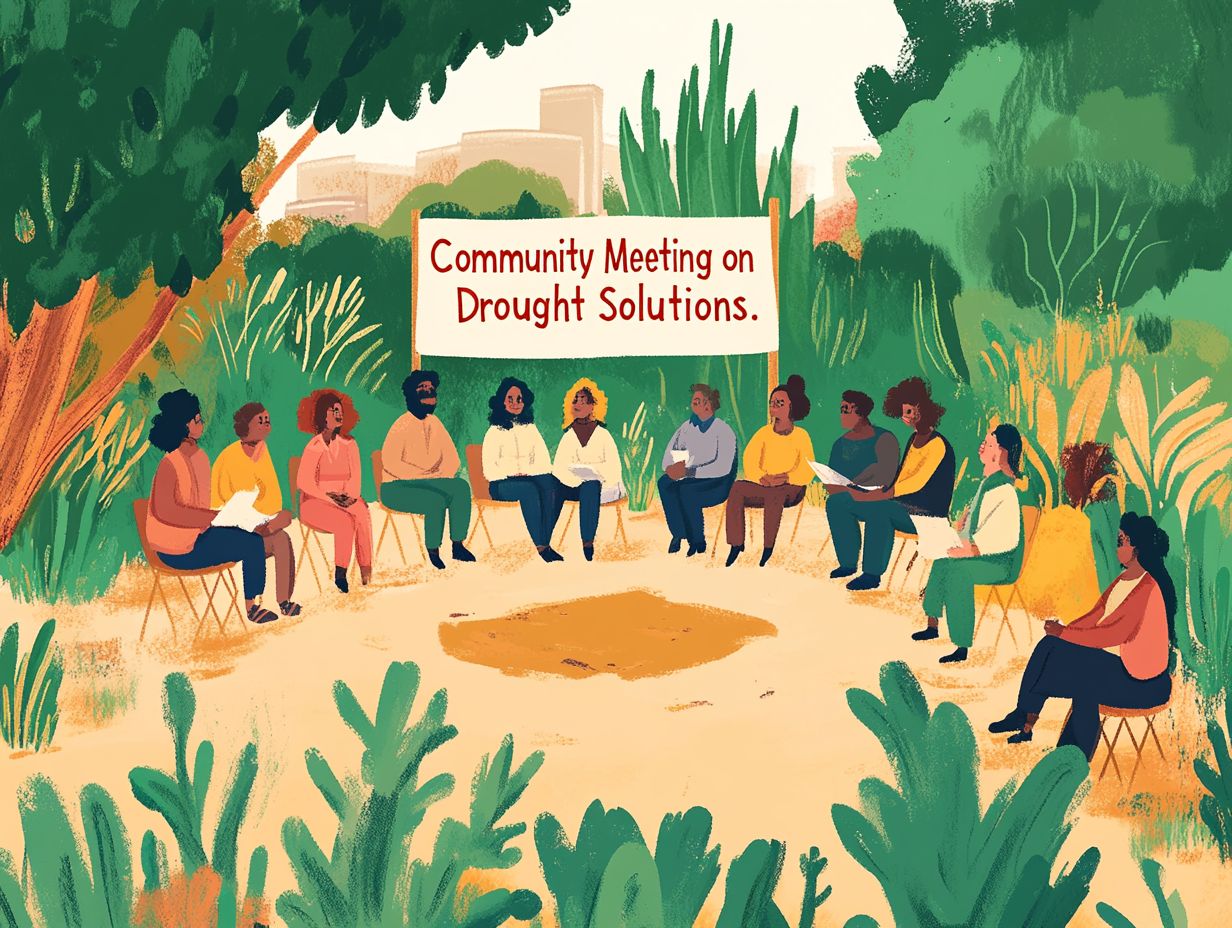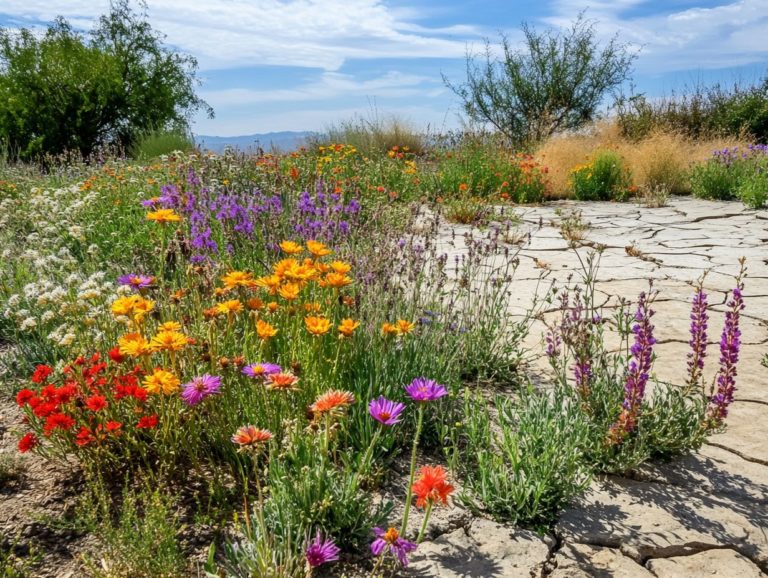How to Engage with the Community on Drought Issues?
Drought isn’t just about dry land it’s about affecting lives! It profoundly influences communities, shaping everything from water supply to local economies.
Understanding the causes of drought is essential. Equally vital is your role in engaging with effective management strategies. This article delves into the significance of community involvement in addressing drought, providing practical strategies for fostering communication and collaboration while emphasizing the necessity of addressing local concerns.
By cultivating partnerships and implementing sustainable solutions, you and your community can unite to mitigate the impacts of drought and enhance resilience for the future, including efforts in water conservation and infrastructure improvement.
Contents
- Key Takeaways:
- Understanding Drought and Its Impact on Communities
- Importance of Community Engagement in Drought Management
- Effective Strategies for Engaging with the Community
- Collaborating with Local Organizations and Leaders
- Addressing Community Concerns and Needs
- Ensuring Sustainable Solutions for Drought Management
- Frequently Asked Questions
- What’s the best way to connect with the community about drought challenges?
- Why is it important to engage with the community on drought issues?
- What are some effective ways to communicate with the community about drought issues?
- How can I get the community more involved in drought issue discussions?
- What are some potential challenges when engaging with the community on drought issues?
- How can I make sure my efforts to engage with the community on drought issues are inclusive?
Key Takeaways:

- Understanding the definition and causes of drought is crucial in engaging with the community on drought issues.
- Community involvement in drought management brings benefits such as increased awareness and more effective solutions.
- Effective communication and collaboration with local organizations, along with addressing community concerns, are essential strategies for engaging with the community on drought issues.
Understanding Drought and Its Impact on Communities
Drought represents a sustained period of unusually low rainfall compared to average long-term rainfall for a given region. This situation poses serious challenges for farmers and local communities especially in vulnerable areas like the Klamath River Basin and Colorado River Basin.
The predicament is worsened by climate change, which disrupts precipitation patterns and heightens the frequency of water scarcity events. Such conditions create significant obstacles in agriculture, public health, and ecosystem stability.
As the Biden-Harris administration rolls out drought management strategies, grasping the complex impacts of drought is essential for fostering resilience and promoting long-term growth that is good for people and the environment.
Defining Drought and Its Causes
Drought can be understood as a prolonged period marked by significantly below-average precipitation. This leads to water shortages that adversely impact agriculture, wildlife, and community resilience.
You can examine this phenomenon from various angles. While meteorological definitions highlight the lack of rainfall, agricultural perspectives focus on how these conditions affect crop yields and soil health. Hydrologically, drought presents itself as a depletion of water resources that are crucial for both human consumption and ecosystems.
Factors contributing to drought often include changes in weather patterns and, increasingly, the far-reaching effects of climate change. These disrupt precipitation patterns and amplify the frequency and severity of drought events. Consequently, communities face the pressing challenge of water scarcity, prompting them to adopt enhanced resource management strategies to navigate an uncertain future.
Importance of Community Engagement in Drought Management
Community engagement plays a crucial role in drought management. It cultivates collaboration among local communities, stakeholders, and authorities, leading to more effective and sustainable solutions to the challenges posed by water scarcity.
By involving the public in the planning and execution of drought mitigation strategies, you ensure that the needs and perspectives of those directly affected are taken into account. This ultimately enhances the overall effectiveness of these initiatives.
Fostering strong partnerships allows for sharing resources and knowledge. This is essential for adapting to climate change and bolstering community resilience.
Act now to secure our water future! Join local initiatives and advocate for sustainable practices in your community.
Benefits of Community Involvement
Engaging with the community in drought management brings a wealth of benefits your way, including enhanced economic growth, improved public health, and a greater awareness of water conservation and sustainable practices.
Take California, for example. Local farmers teamed up with community organizations to roll out water-saving irrigation techniques, leading to higher crop yields while using less water. This initiative not only invigorated the local economy but also cultivated a shared sense of responsibility for sustainable water management.
Similarly, in Australia, residents have jumped into action with rainwater harvesting campaigns. These efforts ease the strain on municipal water supplies. Through workshops and educational programs, communities have become increasingly aware of their water footprint, which measures the amount of water used in daily activities. This promotes healthier lifestyles and nurtures a culture of sustainability that ultimately benefits both the environment and public health.
Effective Strategies for Engaging with the Community

Implementing effective strategies for engaging with the community is essential in drought management. These approaches enhance communication, raise awareness, and foster collaboration among stakeholders.
Use outreach techniques, such as:
- Workshops
- Social media campaigns
- Local advisory committees
This ensures information reaches various demographics, amplifying the impact of your educational initiatives. Start implementing these strategies today to make a real difference in your community s water conservation efforts!
Emphasizing shared resources and knowledge allows communities to better prepare for the challenges posed by drought and climate change, ultimately leading to a more resilient future.
Communication and Outreach Techniques
Effective communication and outreach techniques are essential for raising community awareness about drought issues and promoting sustainable water practices.
Employ a diverse array of communication methods think interactive workshops, dynamic social media campaigns, and open community meetings. You can actively engage the public in drought management efforts by tailoring your messages to different audience segments, ensuring that each group receives relevant information that resonates with their unique experiences and concerns.
For example, workshops designed for local farmers can offer specialized strategies for efficient irrigation. Meanwhile, your social media initiatives can captivate younger audiences with striking visuals and shareable content. This multi-faceted approach not only deepens understanding but also nurtures a shared commitment to water conservation.
Collaborating with Local Organizations and Leaders
Collaborating with local organizations and leaders is vital for effective drought management, as it harnesses a wealth of expertise and resources to tackle the challenges of water scarcity more adeptly.
By fostering partnerships among agricultural businesses, community groups, and governmental agencies, you can facilitate knowledge sharing, implement best practices, and craft comprehensive action plans that bolster resilience against the impacts of drought.
This collaborative approach not only enhances resource management but also fortifies community ties.
Building Partnerships and Utilizing Resources
Building robust partnerships and leveraging available resources are essential for successful drought management in your community.
To effectively tackle the challenges that drought presents, begin by identifying potential collaborators think local governments, NGOs, and agricultural cooperatives that align with your goals. Reach out and open lines of communication with these entities to discuss shared objectives and the resources at your disposal.
Once those partnerships take shape, sharing best practices becomes key. Collaborative efforts like joint water conservation initiatives or community education programs can significantly bolster resilience. For instance, when farmers team up with local water authorities to implement rainwater harvesting, they not only conserve invaluable water resources but also cultivate a sense of community. This dynamic enables residents to adapt more effectively to the ongoing impacts of drought.
Addressing Community Concerns and Needs
Addressing community concerns and needs is essential for effective drought management. By ensuring that strategies are tailored to the unique challenges faced by local populations, you create a more resilient and responsive approach.
This thoughtful engagement fosters trust and enhances the overall effectiveness of your efforts in tackling drought-related issues.
Identifying and Responding to Community Needs

Identifying and responding to community needs is crucial when designing effective drought relief strategies that resonate with those affected.
Understanding the local context is vital. You can achieve this through methods that engage residents and gather their insights. Surveys allow individuals to voice their concerns and priorities regarding drought conditions.
Organizing public meetings creates a platform for open dialogue, fostering collaboration among community members and stakeholders.
These approaches help you pinpoint pressing needs and guide appropriate resource allocation. By tailoring support based on feedback, you empower communities and enhance the effectiveness of relief efforts, paving the way for more sustainable solutions.
Ensuring Sustainable Solutions for Drought Management
Ensuring sustainable solutions for drought management requires implementing long-term strategies that address water scarcity while safeguarding local ecosystems and fostering conservation efforts.
By taking this overall strategy, you combat the immediate challenges of drought and contribute to the preservation of the environment for future generations.
Implementing Long-Term Strategies and Solutions
Implementing long-term strategies and solutions is essential for navigating the challenges posed by drought, ensuring the sustainability of your water resources.
This involves enhancing existing infrastructure, such as reservoirs (large storage areas for water) and pipelines (tubes used to transport water), while investing in technologies that optimize your water usage.
For example, smart irrigation systems use sensors to water plants more efficiently, dramatically minimizing wasted water in agricultural settings. This can significantly improve crop yield and hydration during dry spells.
Local initiatives like water conservation programs and rainwater harvesting projects can lead to remarkable results. In California, community efforts have proven that teamwork can secure water supplies even during severe droughts.
Frequently Asked Questions
What’s the best way to connect with the community about drought challenges?
The best way to engage with the community on drought issues is to understand their needs and concerns. This can be accomplished through surveys, focus groups, or community meetings. Once you have a better understanding of their perspective, tailor your approach to effectively communicate and engage.
Why is it important to engage with the community on drought issues?

Engaging with the community on drought issues is vital because it allows for a collaborative and inclusive approach to addressing the problem. Community members provide valuable insights and solutions, and involving them in the process increases awareness and promotes action.
What are some effective ways to communicate with the community about drought issues?
Effective ways to communicate about drought issues include using various channels such as social media, local newspapers, and community newsletters. It s important to use clear and concise language, providing relevant and timely information.
How can I get the community more involved in drought issue discussions?
One way to involve the community is to host interactive workshops or events. Here, community members can share their experiences and ideas.
You can also encourage them to join local organizations or committees focused on drought issues.
What are some potential challenges when engaging with the community on drought issues?
Engaging with the community on drought issues can come with challenges. These include a lack of trust or interest, conflicting opinions, and limited resources.
Let s tackle these challenges head-on by being clear about our actions, listening to people s worries, and finding ways to collaborate and prioritize actions.
How can I make sure my efforts to engage with the community on drought issues are inclusive?
To ensure inclusivity, it s essential to involve a diverse group of community members in discussions and decision-making processes.
You can achieve this by reaching out to different demographics, providing translation services, and considering various perspectives and needs.
Creating a safe and respectful environment is essential for all participants.
We need your voice now more than ever!






